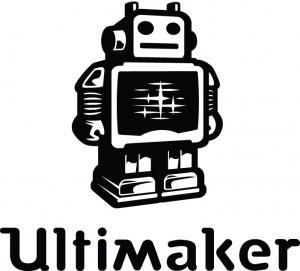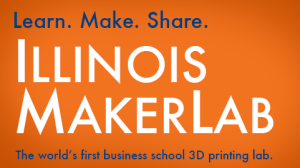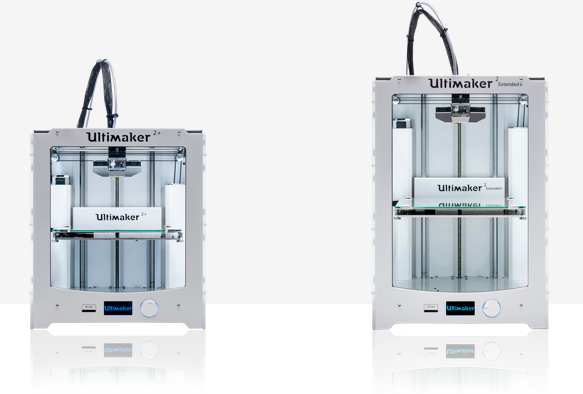 If the 3D printing world held a popularity contest, Ultimaker would be way up there. In fact, the 3D Hubs Trend Report, which is about as close as the industry comes to a popularity contest, has shown the Ultimaker 2 to consistently rank at the top of the “Most Wanted Printers” category. If you’re on the list of those considering an Ultimaker as your next printer purchase, be glad you held off, because the company has just released two new and improved versions of their most advanced printer. This week at CES 2016, Ultimaker is unveiling its latest offerings: the Ultimaker 2+ and the Ultimaker 2 Extended+.
If the 3D printing world held a popularity contest, Ultimaker would be way up there. In fact, the 3D Hubs Trend Report, which is about as close as the industry comes to a popularity contest, has shown the Ultimaker 2 to consistently rank at the top of the “Most Wanted Printers” category. If you’re on the list of those considering an Ultimaker as your next printer purchase, be glad you held off, because the company has just released two new and improved versions of their most advanced printer. This week at CES 2016, Ultimaker is unveiling its latest offerings: the Ultimaker 2+ and the Ultimaker 2 Extended+.
“We are excited to release two new 3D printers at CES this year,” says Jos Burger, CEO of Ultimaker. “The Ultimaker 2+ and Ultimaker 2 Extended+ are results of countless collaborations and insightful feedback we have received from the Ultimaker community. Both printers feature crucial upgrades based on what our customers are looking for in a 3D printer.”
Those upgrades include interchangeable nozzles that can be easily removed and replaced in what appears to be a built-in version of the company’s customer-invented Olsson Block. A new, more powerful geared feeder prevents print skipping, allowing for optimized results, and an improved cooling system enhances the surface quality of finished prints.
The main difference between the $2,499 Ultimaker 2+ and the $2,999 2 Extended+ is size; the full dimensions of the 2+ are 493 x 342 x 588 mm, while the 2 Extended+ measures 493 x 342 x 688 mm. Additional specifications include:
- Build volume: 223 x 223 x 205 mm (2+); 223 x 223 x 305 mm (2 Extended+)
- Build plate: 50˚ to 100˚ C heated glass build plate
- Print technology: Fused Filament Fabrication (FFF)
- Print head travel speed: 30 to 300 mm/s
- XYZ accuracy: 12.5, 12.5, 5 micron
- Nozzle temperature: 180˚ to 260˚ C
Nozzles for both printers come in four sizes: 0.25 mm, 0.40 mm, 0.60 mm, and 0.80 mm. Build speed and layer resolution vary depending on the size of the nozzle being used. The printers are optimized for PLA, ABS and CPE filament, but can support any filament type. You can get a closer look at the new printers below:
In addition to the unveiling of their new printers, Ultimaker is also going to be spending some time at CES discussing their plans and goals for 2016. 2015 was a fantastic year for the company, with their annual revenue doubling from 2015 to 2016. 35% of those sales came from customers in North America, and the company expects that they will become the leading provider of desktop 3D printers in 2016.
 Like many 3D printing companies, Ultimaker is pursuing the education sector, as that’s where the fastest growth appears to be coming from. In partnership with Illinois Makerlab at the University of Illinois, Ultimaker is developing a new massive open online course (MOOC) on 3D printing that will be released via Coursera later this year.
Like many 3D printing companies, Ultimaker is pursuing the education sector, as that’s where the fastest growth appears to be coming from. In partnership with Illinois Makerlab at the University of Illinois, Ultimaker is developing a new massive open online course (MOOC) on 3D printing that will be released via Coursera later this year.
“We have seen great success this year with professionals and educators who can optimize the modular components of our infrastructure for their own specific needs,” says Burger. “Ultimaker has seen an expansion of sales within industries such as Aerospace, Automotive, Healthcare, Energy and Education especially within engineering, design and manufacturing in the past year. We look forward to see how Ultimaker’s global community will continue to grow and help it create the products of the future.”
Let’s hear your thoughts on these two new machines in the Ultimaker 2+ 3D Printer forum on 3DPB.com.
Subscribe to Our Email Newsletter
Stay up-to-date on all the latest news from the 3D printing industry and receive information and offers from third party vendors.
You May Also Like
Precision at the Microscale: UK Researchers Advance Medical Devices with BMF’s 3D Printing Tech
University of Nottingham researchers are using Boston Micro Fabrication‘s (BMF) 3D printing technology to develop medical devices that improve compatibility with human tissue. Funded by a UK grant, this project...
3D Printing Webinar and Event Roundup: April 21, 2024
It’s another busy week of webinars and events, starting with Hannover Messe in Germany and continuing with Metalcasting Congress, Chinaplas, TechBlick’s Innovation Festival, and more. Stratasys continues its advanced training...
3D Printing Webinar and Event Roundup: March 17, 2024
It’s another busy week of webinars and events, including SALMED 2024 and AM Forum in Berlin. Stratasys continues its in-person training and is offering two webinars, ASTM is holding a...
3D Printed Micro Antenna is 15% Smaller and 6X Lighter
Horizon Microtechnologies has achieved success in creating a high-frequency D-Band horn antenna through micro 3D printing. However, this achievement did not rely solely on 3D printing; it involved a combination...






























